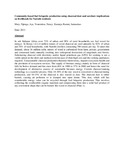Community-based fuel briquette production using charcoal dust and sawdust: implications on livelihoods for Nairobi residents

View/
Date
2011Author
Mary, Njenga
Aya, Yonemitsu
Nancy, Karanja
Ramni, Jamnadass
Type
ArticleLanguage
enMetadata
Show full item recordAbstract
In sub Saharan Africa over 72% of urban and 98% of rural households use fuelwood for energy). In Kenya 1.6-2.4 million tonnes of wood charcoal are used annually by 82% of urban and 34% of rural households, with Nairobi dwellers consuming 700 tonnes per day. To meet this demand, about 16 million cubic meters of wood is carbonized from farm, private, government and communal lands annually resulting into widespread destruction of rangelands and forests. Substituting charcoal with electricity and/or liquid petroleum gas (LPG) for cooking is not a viable option in the short and medium term because of their high cost and the cooking appliances required. Unsustainable charcoal production threatens biodiversity, impairs ecosystem health and the provision of ecosystem services. The supply of biomass energy mainly in form of charcoal falls far below demand and has risen from 46% in 1980 to 57% in 2000 and hence the need for development of alternative sources of sustainable biomass energy.
Current charcoal-making technology is a wasteful process. Only 10-30% of the raw wood is converted to charcoal during production, and 10-15% of the charcoal is also wasted as dust. The charcoal dust is either burned, causing air pollution or is dumped into open drains. This dust, which still has considerable energy value can be recycled through fuel briquette production. This involves collecting the combustible organic materials and compressing them into a solid fuel product of any convenient shape that can be burned like wood or charcoal (Plate 1).
Citation
Miti. The Tree Business Magazine for Africa Issue No.12 October-December 2011Publisher
World Agroforestry Centre (ICRAF) University of Tsukuba, Japan Department of Land Resource Management & Agricultural Technology, University of Nairobi, Kenya
